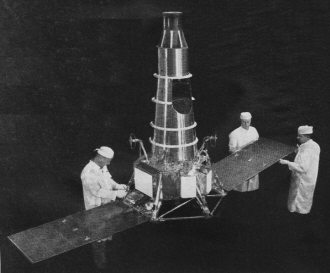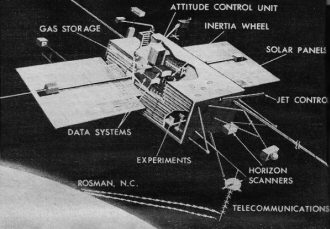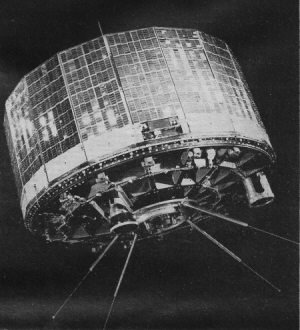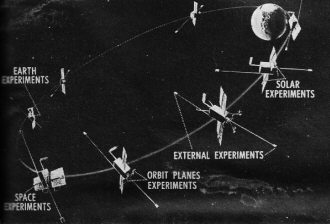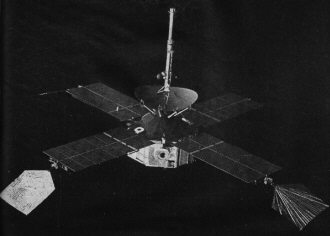Experiments in Space
|
|
Space exploitation and exploration has always advanced quickly. Sputnik and Explorer were launched in 1957 and 1958, respectively. They were the world's first artificial satellites, and had only one-way communications from onboard scientific payloads to earth stations which picked up the signals (many amateur radio operators received the data as well). In a little over half a decade, multiple two-way communications satellites were in orbit, and instrumented probes had already reached the moon, Venus, and Mars. Results of the International Geophysical Year (IGY) effort are rightfully credited with setting everything in motion. This article from a 1965 issue of Popular Electronics magazine reports on the state of the art in satellite technology. Not mentioned is the concurrent rapid advances being made in rockets, tracking stations, and orbital and space navigation capabilities which were an integral part of the program. Experiments in Space By Joseph H. Wukek, Jr. New knowledge, new processes and techniques, new materials, and new designs have all come out of our scientific program for the exploration of space. Article describes sounding rockets, scientific satellites, and deep-space probes. Editor's Note: The following article is the first ill a group of stories that will cover details on our scientific experiments in space. This article covers the subject from a general point of view. Subsequent stories will go into far more detail on each of the many experiments that are now being conducted. Such items as the purpose of the various experiments, how each one operates, the special transducers used, and how the information is transmitted back to earth will be included. With the technological advances in rocketry during the past twenty years, new regions for exploration were opened to Man. No longer would scientists and engineers be satisfied to study only the phenomena of our earth and its atmosphere, or view that small fraction of the universe visible through telescopes. With rockets probing several hundred miles above the earth, more information could be gathered about our globe and its surroundings than was heretofore possible. In 1957 the USSR launched the first artificial earth satellite. Since that time, payload capabilities of launch vehicles have steadily increased, so that now we find a variety of instrumented package in space. We are no longer limited to several hundred miles altitude, or to an earth orbit. The United States has successfully launched space probes to the Moon and Venus (Rangers 7, 8, 9, and Mariner 2, respectively) and at the time this was written another Mariner probe (Mariner 4) is enroute to Mars, some 35 million miles away. (Mariner will, in fact, cover over 100 million miles enroute to Mars, but the intercept with the distant planet will be made at the 35-million-mile distance.) Why Space Experiments? In any undertaking as expensive as the U.S. space program, and it is expensive, a citizen might reasonably ask, "Why?" The classic answer of Sir Edmund Hillary, who, when asked why he led an expedition in scaling Mount Everest, replied, "Because it was there," is probably an unsatisfactory answer to many critics of the program. They argue with some justification that these funds might be better spent on cancer research, or education, or a host of other worthwhile pursuits. Beyond improving our prestige as a nation of technological "doers," the space program has had other benefits. Communications and weather-predicting satellites benefit most of the earth's inhabitants. In pushing the "state of the art" to new levels, a kind of "technological fall-out" has taken place. New knowledge gained in the space program has found applications elsewhere. New processes and techniques, new materials, and new designs have been spawned by work in the aerospace industry. Much of the impetus given to the development of integrated circuits has come from the space program. These circuits will make possible small, low-powered, reliable, and inexpensive electronic equipment. The field of medical electronics benefits by the research in medical instrumentation. The proposed U. S. Supersonic Transport (SST) will rely heavily on knowledge gained in the space program. In addition to the important new knowledge gained, American industry and commerce stand to gain from these efforts, and thus the citizen will ultimately benefit. Artist's concept of OGO with its 220 lbs. of scientific instruments which are used to investigate aurora and radiation. Tiros is designed to photograph meteorological conditions. If we limit our discussion to unmanned space vehicles and only those vehicles which have been launched to date, three categories are suggested: 1. sounding rockets, 2. satellites, and 3. deep-space probes. Sounding Rockets. Sounding rockets are vehicles designed to pass through the region of up to several hundred miles above the earth. These rockets are usually smaller vehicles, up to 50 feet in length. The lifetime of these probes is on the order of several minutes. Information is relayed via telemetry (TM) channels, and/or a recovery of the instrument package may be effected by parachute and floatation bag if the re-entry is over water. These experiments are relatively inexpensive since older, obsolescent rockets may be used, and the ground support requirements are minimal. The launch vehicle may be one or several stages of rocket, with the experiment mounted in a detachable nose cone. Satellites. Satellites are vehicles which are designed to orbit a planet and, in particular, the Earth. Schemes for orbiting other planets have been described, but we limit our discussion to earth satellites. The Orbiting Geophysical Observatories (OGO) are an example of the new generation of satellites. The eccentric-orbiting version (EGO), will be launched by the two-stage Atlas-Agena B to an orbit of 68,000 miles maximum (apogee), to 175 miles minimum (perigee). The polar-orbiting version of the satellite (POGO) will have apogee and perigee of about 570 and 150 miles, respectively. POGO will be launched by Thor-Agena. At this writing, one EGO satellite is in orbit. Many other earth satellites have been launched or are in the development stage. Some of these are for scientific measurements. Others, such as the Syncom, Telstar, and Echo are primarily communications satellites. So-called active satellites contain receiver/transmitter equipment to receive, amplify, and re-transmit high-frequency r.f. over the horizon. Passive satellites such as Echo, merely act as reflectors for r.f. transmission. Yet another class of satellites is the Tiros (Television Infrared Observation Satellite) type, used to gather data for weather prediction. Deep-Space Probes. This class of vehicle ordinarily contains equipment similar to that of sounding rockets and earth satellites, but has a mission in deep-space. The Mariner 2 vehicle which passed Venus in mid-December 1962 was of this category, as were the Ranger Moon probes. Experiments in Space While a wide variety of approaches to instrumentation exists for each particular experiment, most experiments may be classified as one of six general types: 1. micrometeoroid measurements, 2. magnetic measurements, 3. solar-plasma measurements, 4. radiation measurements, 5. wave-propagation measurements, and 6. astronomical observations. Micrometeoroid Measurements. The far reaches of space abound in cosmic debris. We are familiar with meteors and meteorites, which are seen burning in the earth's atmosphere or occasionally find their way to a collision with the earth's surface. These particles may be seen either by optical means or radar. General types of experiments performed by the EGO satellite. The Mariner satellite, which is now on its way to the planet Mars. But many smaller parts, too small to be seen by radar, exist above the earth's atmosphere. Particles of less than 1 millimeter diameter (a bout 4/100th of an inch) are called micro-meteoroids. These particles may be traveling at speeds of up to 100,000 feet per second (more than 68,000 miles per hour), and hence could prove hazardous to a manned space vehicle. This cosmic dust, moving at high velocities, has a "sandblasting" effect on materials. Solar batteries used for power aboard satellites may have their efficiency impaired by the eroding effect of the "sandblast." By measuring the size, velocity, and abundance of these particles, scientists and engineers hope to be able to determine the level of hazard these particles represent. The recently orbited Pegasus satellite is being used to take such measurements. Magnetic Measurements. Of itself, the earth's magnetic field is of interest. A detailed measurement and mapping of the earth's field will aid in understanding related phenomena. Trapped radiation, the aurora, radio propagation through space, and magnetic storms are believed related in some measure to the magnetic field of the earth. The presence and strength, or absence, of magnetic fields in the vicinity of a planet or our moon give some indication of that body's composition. Hence we find that magnetic field measurements are of interest in virtually every satellite or deep-space mission. Solar Plasma. Solar plasma, or solar winds, are tremendous hydrogen clouds which emanate from the Sun. These clouds move at several hundred miles per second and contain α particles (helium ions with + 2 electron charge), protons, and electrons as well as hydro-gen. Measurements to date indicate that the solar plasma is always present but is subject to broad fluctuations in composition and energy. Moreover, the times of increased solar activity, as with solar flares, have a marked effect on the plasma. Radio communication is greatly affected during solar flares, and extraterrestrial radio noise increases. The origin and mechanism of solar plasma is not well understood at this time. It is hoped that further experimentation will assist in a better understanding of the nature of this phenomenon. Radiation Measurements. With the discovery by Van Allen of the radiation belts which bear his name, much interest was aroused in space radiation measurements. In addition to these natural belts of radiation, U.S. and Soviet high-altitude nuclear explosions have added charged particles to these regions, altering the Van Allen belts' composition and shape. While the Van Allen belts are believed to be primarily high-speed electrons and protons, more measurements are needed to better chart these regions. Clearly, these radiation regions could prove hazardous to space travelers. In addition to electron/proton radiation, other radiations are found in space. Gamma rays (γ rays, similar to high-energy x-rays ), cosmic rays, and particles emitted from the sun are also of interest. Also, since our atmosphere filters much of the radiation from the sun, measurements of solar radiation made above the atmosphere will yield more information about the sun. With such an abundance and mixture of particles and waves, more experimental work is in order. Wave-Propagation Measurements. Since we rely heavily upon the properties of the ionosphere for much of our radio communication, it behooves us to seek a better understanding of this region. The radio propagation properties of the ionosphere are subject to variation from day to evening, and with the seasons. Solar activity, particularly the eleven-year sunspot cycle, produces severe changes in the ionosphere. In addition to radio propagation measurements, noise measurements are also of interest. Astronomical Measurements. Since the earth's atmosphere greatly reduces the resolving power of terrestrial telescopes, we find it desirable to make observations from above this region. Hence telescopes and/or TV cameras aboard satellites and probes can give improved resolution to astronomical observations. This fact was dramatically illustrated when the TV camera aboard Ranger 7 showed the Moon's surface with a resolution of 1 1/2 feet, some 1000 times better than any earth telescope. Related to this type of experiment are the meteorological satellites, which look toward, rather than away from, the earth. By relaying photographs of cloud formations and earth heat radiation patterns, meteorologists have added information at their disposal for predicting the weather. The Tiros satellite in 1961 warned of the approach of hurricane Esther two days before conventional systems detected its buildup. In addition to the kinds of measurements we have discussed, most space vehicles carry so-called "housekeeping" instruments. These devices monitor and transmit information having to do with the spacecraft itself. Temperatures, pressures, power bus voltages, attitude (orientation of spacecraft), vibration, acceleration, shock, velocity, time from launch, etc. are of interest during launch and over extended periods of the vehicle's mission. Housekeeping data is usually transmitted by the telemetry equipment at a slower rate than experimental data since usually housekeeping data is changing at a slower rate. During launch it may be that only housekeeping data is transmitted, and experiments might not be turned on until the region of interest is reached.
Posted August 30, 2022 |
|

